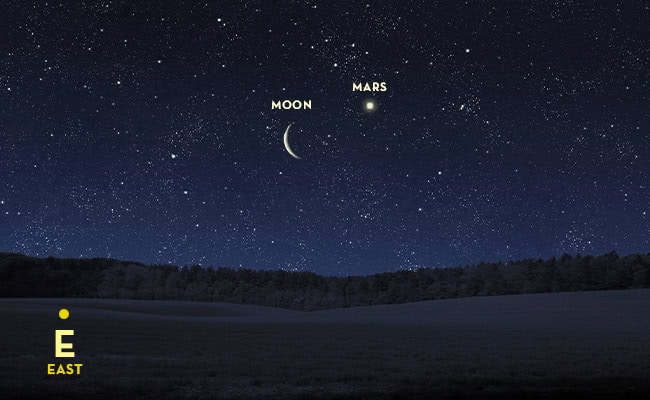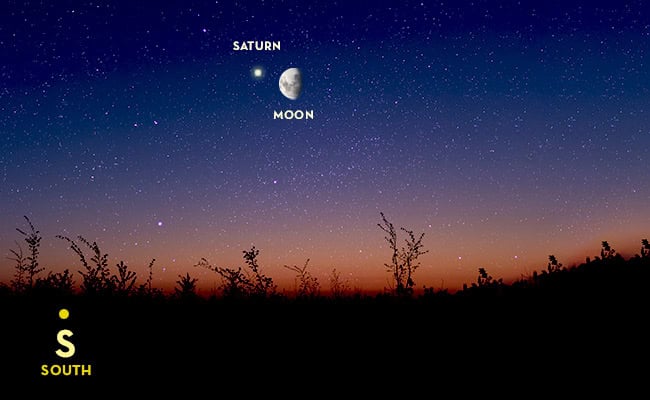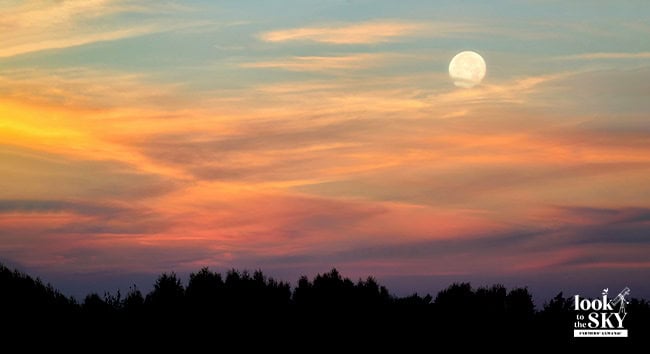The June night sky has many highlights, including the first full Moon of summer followed by the kick-off of this year’s Parade of Planets! Spark conversation and feast your eyes on unique sights with our June Night Sky Guide 2024. Farmers’ Almanac expert astronomical reports have been in continuous publication since 1818.

June Night Sky Guide
All times and positions are listed in Eastern time, 40 degrees north of the equator—unless otherwise specified. If you see the terms sunset, midnight, sunrise or local time, this is true no matter where you are located (no need to add or subtract for your time zone).
Any questions? Contact [email protected]
Look for the telescope emoji – 🔭 – which means that we recommend binoculars or telescopes. Psst … you can find great astronomy gear at affordable prices in our Starry Nights Gift Guide.
⭐ June 3 – Crescent Moon And Mars
Look very low toward the east around 4 a.m. local time to see a slender crescent Moon. About six degrees to the right is a relatively bright (magnitude +1.0) orange “star,” the planet Mars.

After spending the first half of 2024 submerged in the Sun’s morning glow, Mars now rises before morning twilight. Early-risers may catch it hanging about twelve degrees above the eastern horizon one hour before sunrise at the beginning of June and rising higher and higher in the sky as the month progresses—24 degrees high (about the distance of your outstretched palm) by month’s end.
🔭 June 4 – Mercury And Jupiter
This morning presents two bright planets coming exceptionally close to each other, as Mercury passes a mere 0.1 degrees south of Jupiter. This would be a very striking sight if these planets were situated farther away from the Sun in the sky, but unfortunately both are situated only 12 degrees west of the Sun, placing them very low near the east-northeast horizon and therefore lost in bright morning light.
Up for a challenge? Use binoculars and slowly scan just above the east-northeast horizon about a half-hour before sunrise.
Mercury is rapidly heading for conjunction with the Sun in ten days. As for Jupiter, it begins June rising only about 30 minutes before the Sun, but by month’s end that figure swells to more than two hours. Jupiter shines at magnitude -2.0 roughly between Aldebaran and the Pleiades.
Also today, Venus is on the far side of the Sun (superior conjunction). So, this normally prominent planet is lost in the solar glare all month. In fact, it will actually pass directly behind the Sun, as it has done every June at 8-year intervals since 1976, a 10-event series that will come to an end in the year 2048.
🔭 June 5 — Crescent Moon, Mercury And Jupiter
The challenge continues on this early morning. Early risers: See if you can spot the crescent Moon along with Mercury and Jupiter. Look east before sunrise.
June 6 – New Moon
June’s New Moon occurs on June 6, 2024 at 8:38 a.m. EDT. (Note: Full Moons and New Moons are opposites.)
New Moons are great times to see the stars. Learn why!
June 7 — New Moon “Star View” – Libra
Well-known for being in the zodiac but not much to look at is the constellation of Libra, the Scales. This week you’ll find it about one-third of the way up in the southern sky at about 11 p.m. local daylight time.
One early version of how this star pattern came to be holds that Libra was intended to symbolize the equality of day and night, which occurred when the Sun was entering this constellation more than 3,000 years ago. At that time, the autumnal equinox took place in Libra.
Interestingly, ancient star atlases depicting the adjacent constellation of Scorpius included the stars of Libra to represent the Scorpion’s claws. This history is preserved in the names of these stars. Zubeneschamali is from the old Arabic meaning “The Northern Claw,” and Zubenelgenubi means “The Southern Claw.”
Today, however, based on international agreement, there is a strict division of these two constellations. Zubeneschamali, which appears whitish to some, has been described by others as possessing a “beautiful pale green” hue and is possibly the only naked-eye star that is green in color.
🔭 June 9 — Saturn Reaches Quadrature
Saturn reaches western quadrature on June 9, 2024. Throughout this month, telescope users should notice Saturn’s shadow on the rings just off to the west (“preceding”) side of the planet.
June 14 — First Quarter Moon
The first quarter Moon occurs at 1:18 a.m.
Also, Mercury reaches superior conjunction today (a day after passing the perihelion point of its orbit). Hence this inner planet emerges very quickly into the evening sky.
Any questions? Contact [email protected]
June 20 — Summer Solstice — Earliest In 128 Years!
The Sun reaches the solstice, its northernmost point on the celestial sphere, at 4:51 p.m. EDT and thereafter begins its six-month return south. This ushers in summer in the Northern Hemisphere and winter in the Southern Hemisphere. This is the earliest summer solstice in 128 years.
As astronomy books explain, the plane of the Earth’s Equator is tilted 23.5 degrees to our orbit around the Sun. During the year varying amounts of sunlight strike different regions of the planet. Both the angle of incidence of the radiation and the length of daylight changes significantly. If the insolation (the total energy received from the Sun) alone governed the temperature, we would now be experiencing the year’s hottest weather. But the atmosphere in temperate regions continues to receive more heat than it gives up to space—a situation that lasts several weeks or more.
A reverse process occurs after the winter solstice in late December. Thus, there is a temperature lag of about a month: our hottest weather usually comes in late July and our coldest in late January. Another factor is the Sun’s path across the sky and the number of hours it is above the horizon.
⭐ June 21 — Full Strawberry Moon
The Strawberry Moon will become full on this first full day of summer, at 9:08 p.m. EDT.
Based on its golden appearance at this time of year, some people refer to the June full Moon as the “Honey Moon.” What causes this phenomenon? The Sun in June is at its greatest distance to the north of the celestial equator and the full Moon (which is nearly opposite to the Sun in the sky) is therefore at its greatest distance to the south of the celestial equator. The full Moon of June is therefore seen especially low in the southern sky. Objects seen low in the sky are affected by the reddening properties of the atmosphere. Consequently, the full Moon in June usually has a beautiful golden appearance, just like honey.
There are many other effects of atmospheric reddening. The most obvious is the rising or setting Sun. When the sunlight passes through a great thickness of the atmosphere, most of the blue light is absorbed and scattered away, but the red light comes through.
The reddening of stars when they are seen close to the horizon is perhaps less obvious to the casual observer. Finally, the red color of the Moon during a total lunar eclipse is due to sunlight being reddened as it passes through the Earth’s atmosphere and then bent by refraction into the Earth’s shadow.
June 22 — Mercury Becomes An “Evening” Star
Skywatchers at mid-northern latitudes may begin to see Mercury in the evening sky without optical aid starting today, June 22, 2024. Though we recommend viewing this elusive planet in early July, when you will have a better shot of spotting it!
Don’t want to wait? By the end of June, Mercury will be far enough from the Sun to remain in the sky for a short time after sunset. Look very low on the west-northwest horizon approximately 45 minutes after sunset.
June 24 — Parade Of Planets 2024 Is Coming …
We are excited to announce that beginning on this morning, St. John’s Day, you can begin to watch for the Parade of Planets 2024! Though some news outlets reported that this event would take place earlier in June, we recommend July 3 (not June 3). Here is a brief explanation of this event—including a special note about June 24, 2024 regarding the Moon and Pluto! Stay tuned for more information.
⭐ June 27 — Moon Kisses Saturn
A repeat affair of last month (May 31), the Moon will “kiss” Saturn before sunrise on June 27, 2024. Look southeast between 3-4 a.m. local time. You’ll see a waning gibbous Moon and shining about four degrees to the left will be a relatively bright (magnitude +1.1) light glowing with a yellowish-white tint: Saturn.

The ringed planet rises in the east-southeast around 2 a.m. at the beginning of June, and about two hours earlier at month’s end. The best view comes as the eastern sky is beginning to brighten, when Saturn hangs fairly high in the southeast. Saturn begins retrograde motion against the starry background on June 30.
Any questions? Contact [email protected]
June 28 – Last Quarter Moon
The last quarter Moon occurs at 5:53 p.m. EDT.
June 30 – Mercury And Gemini Form A Line
On June 30, 2024, Mercury forms a nearly perfect straight line with the “Twin Stars” of Gemini: Castor and Pollux. Look west north-west just after sunset. Note: This will be extremely tough to see as Mercury will be very low on the horizon and still very close to the Sun.
Join The Discussion
Which sky event are you looking forward to in the June night sky?
Do you have any questions or suggestions for our sky guide?
Share with your community here in the comments below!

Joe Rao
Joe Rao is an esteemed astronomer who writes for Space.com, Sky & Telescope, and Natural History Magazine. Mr. Rao is a regular contributor to the Farmers' Almanacand serves as an associate lecturer for the Hayden Planetarium in New York City.











